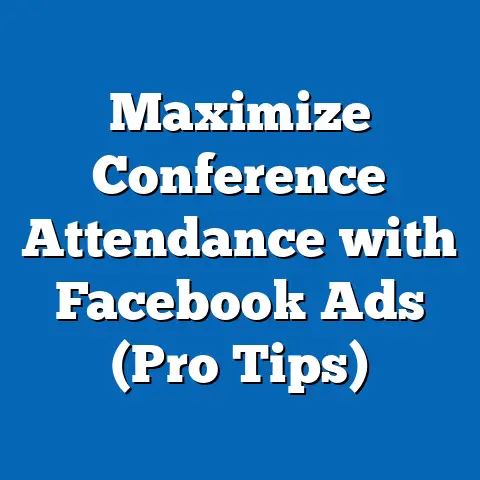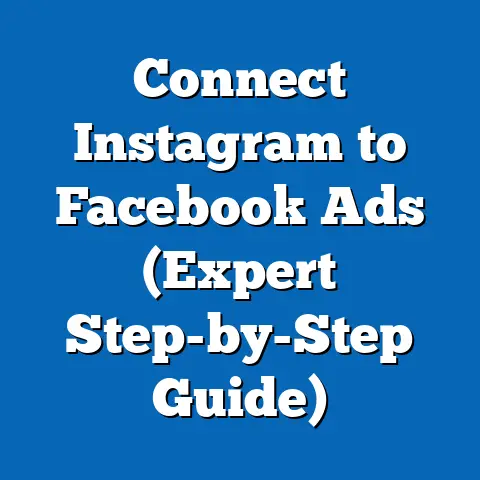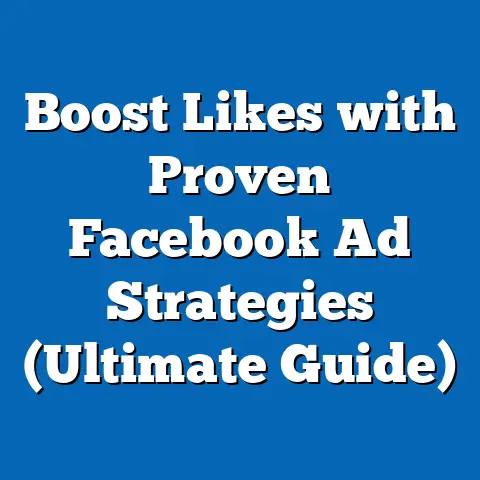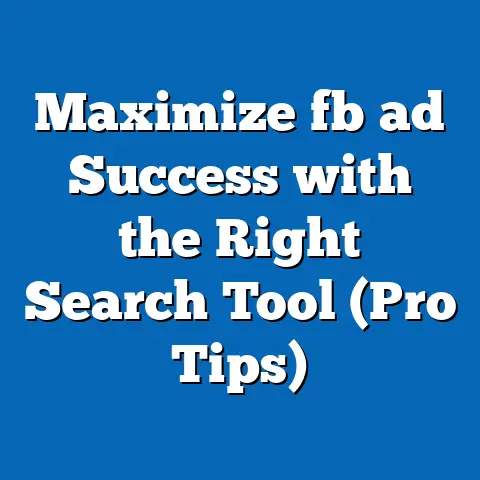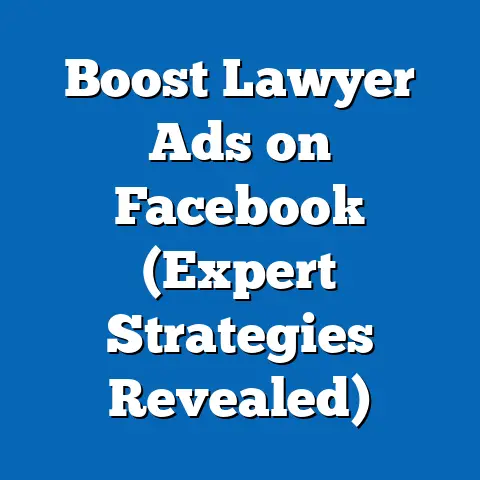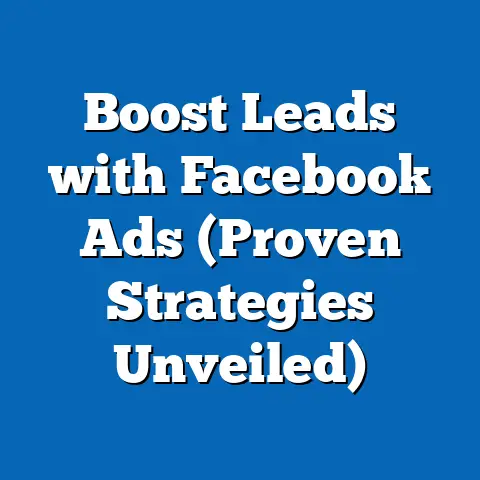Create Ads Without a Facebook Page (Strategic Insider Tips)
What if you could tap into the vast audience of Facebook without having to create a Facebook Page? Imagine being able to promote your brand or product directly to millions of potential customers, all while bypassing the need for a social media presence. For years, I thought a Facebook Page was the only way to advertise on the platform. Turns out, that’s not entirely true! This scenario isn’t just a fantasy; it’s a reality for savvy marketers who understand the intricacies of Facebook advertising. In this article, I’m going to share strategic insider tips that allow you to create effective Facebook ads without the constraints of a Facebook Page. I’ll walk you through everything I’ve learned, from setting up your ad account to crafting compelling content and analyzing performance. Let’s dive in!
Understanding Facebook’s Ad Platform
Facebook’s advertising platform is a powerhouse, connecting businesses with a massive audience of potential customers. It’s not just about slapping up an ad and hoping for the best; it’s about strategic targeting, compelling creative, and data-driven optimization. Let’s break down how this giant works.
How Facebook Ads Work
Think of Facebook’s ad platform as an auction. Advertisers bid for the attention of users based on various criteria, like demographics, interests, and behaviors. When a user matches the criteria you’ve set, your ad enters the auction. The winning ad gets shown to that user. This happens millions of times per second across the globe.
There are several types of ads you can create, each designed for different objectives:
- Image Ads: Simple and effective, featuring a single image and accompanying text.
- Video Ads: More engaging than image ads, allowing you to tell a story and capture attention.
- Carousel Ads: Showcase multiple images or videos in a single ad, perfect for highlighting different products or features.
- Collection Ads: Designed for mobile shopping, allowing users to browse and purchase products directly from the ad.
- Lead Ads: Collect leads directly within Facebook, making it easy for potential customers to provide their information.
- Instant Experience Ads: Full-screen, mobile-optimized experiences that load quickly and provide an immersive way to engage with your brand.
Benefits of Using Facebook Ads
The power of Facebook Ads lies in its incredible targeting capabilities. You can target users based on:
- Demographics: Age, gender, location, education, job title, and more.
- Interests: Hobbies, passions, and things they’ve liked on Facebook.
- Behaviors: Purchase history, online activity, and device usage.
- Connections: People who like your Page, their friends, or people who have interacted with your app.
- Custom Audiences: Upload your own customer list to target existing customers or create lookalike audiences.
This level of precision allows you to reach the right people with the right message, increasing the likelihood of conversions and ROI. The potential reach is enormous, with billions of active users on Facebook and Instagram. Even with a small budget, you can reach a significant portion of your target audience.
Running Ads Without a Facebook Page: The Reality
Here’s the kicker: you can run ads on Facebook without a Facebook Page, but with limitations. The key is to use “dark posts,” also known as unpublished posts. These are ads that don’t appear on your Facebook Page’s timeline but are still served to your target audience.
There are a few common misconceptions I want to address:
- Myth: You can’t run ads at all without a Page. False! You can, but it’s best for specific scenarios.
- Myth: It’s easier to run ads without a Page. Not necessarily. It can be more complex to manage, especially if you’re not familiar with Facebook Ads Manager.
- Myth: It’s cheaper to run ads without a Page. Cost isn’t directly related to having or not having a Page. It’s more about your targeting, bidding strategy, and ad quality.
When to Consider Running Ads Without a Page:
- Testing new products or services: You might want to gauge interest without committing to a full-blown Page.
- Promoting specific events or limited-time offers: A short-term campaign might not warrant a permanent Page.
- Driving traffic to your website: If your primary goal is website traffic, a Page might not be necessary.
Takeaway: Facebook’s ad platform is a powerful tool for reaching a vast audience. While having a Facebook Page is generally recommended, running ads without one is possible and can be beneficial in certain situations. Understanding the different ad types, targeting options, and benefits of Facebook Ads is crucial for success.
Next Step: Set up your Facebook Ad account or familiarize yourself with Facebook Business Manager.
The Importance of an Ad Account
Your Facebook Ad account is the central hub for all your advertising activities. It’s where you create, manage, and track your campaigns. Think of it as your control panel for reaching millions of potential customers.
Setting Up a Facebook Ad Account
Setting up an ad account is straightforward, but it’s essential to do it correctly to avoid future headaches. Here’s a step-by-step guide:
- Go to Facebook Business Manager: If you don’t have one, create a Business Manager account. It’s free and allows you to manage multiple ad accounts, Pages, and other business assets.
- Navigate to Ad Accounts: In Business Manager, go to Business Settings, then click on “Ad Accounts.”
- Create a New Ad Account: Click the “Add” button and choose “Create a new ad account.”
- Enter Your Business Details: Provide your business name, country, currency, and time zone.
- Assign People and Permissions: Assign yourself (and any other team members) to the ad account and grant the necessary permissions (e.g., admin, advertiser, analyst).
- Add Payment Information: Add your credit card or PayPal account to fund your ad campaigns.
The Role of Facebook Business Manager
Facebook Business Manager is a game-changer for managing your advertising efforts, especially if you’re working with multiple clients or team members. It allows you to:
- Manage multiple ad accounts and Pages in one place.
- Assign roles and permissions to team members.
- Track performance across all your accounts.
- Create and manage custom audiences and pixels.
- Securely share access to your assets with agencies or partners.
I remember when I first started using Business Manager, I was overwhelmed by all the options. But once I got the hang of it, it became an indispensable tool for managing my clients’ ad campaigns.
Personal Profiles vs. Business Accounts
This is where things get interesting. Technically, you can run ads from your personal Facebook account. However, I strongly advise against it. Here’s why:
- Lack of Professionalism: Using a personal account for business advertising can look unprofessional and damage your brand’s credibility.
- Limited Features: Personal accounts have limited access to advanced targeting options and reporting features.
- Privacy Concerns: Mixing personal and business activities can compromise your privacy and make it harder to manage your account.
- Account Restrictions: Facebook may restrict or ban your personal account if it’s primarily used for commercial purposes.
Takeaway: Setting up a Facebook Ad account is the first step towards running effective campaigns. Facebook Business Manager is essential for managing multiple accounts and team members. While running ads from a personal account is technically possible, it’s not recommended due to the limitations and potential risks.
Next Step: If you haven’t already, create a Facebook Business Manager account and set up your ad account properly.
Target Audience Insights
Targeting the right audience is the cornerstone of any successful Facebook ad campaign. It’s not enough to have a great product or service; you need to get it in front of the people who are most likely to buy it.
Identifying and Defining Your Target Audience
Before you start creating ads, take the time to thoroughly research and define your target audience. Ask yourself these questions:
- Who are my ideal customers?
- What are their demographics (age, gender, location, income, education)?
- What are their interests and hobbies?
- What are their pain points and challenges?
- Where do they spend their time online?
The more specific you can be, the better. Create detailed customer personas that represent your ideal customers. Give them names, write down their backstories, and imagine their daily lives. This will help you tailor your ad messaging and targeting to resonate with them.
The Importance of Audience Segmentation
Not all customers are created equal. Segmenting your audience allows you to deliver more relevant and personalized ads, which can significantly improve your results.
Here are a few ways to segment your audience:
- Demographics: Segment by age, gender, location, or other demographic factors.
- Interests: Segment by interests, hobbies, or passions.
- Behaviors: Segment by purchase history, online activity, or device usage.
- Engagement: Segment by how they’ve interacted with your brand in the past (e.g., website visitors, email subscribers, Page likers).
Utilizing Facebook’s Audience Insights Tool
Facebook Audience Insights is a free tool that provides valuable data about your target audience. It allows you to:
- Learn about the demographics, interests, and behaviors of people on Facebook.
- Discover what Pages they like, what topics they’re interested in, and what activities they engage in.
- Compare your target audience to the general population on Facebook.
To access Audience Insights, go to Facebook Ads Manager, click on “Tools,” and then select “Audience Insights.” You can then choose to analyze either everyone on Facebook or people connected to your Page.
Creating Custom Audiences and Lookalike Audiences
Custom Audiences and Lookalike Audiences are two of the most powerful targeting options available on Facebook.
- Custom Audiences: Allow you to target your existing customers or leads by uploading your own data (e.g., email list, phone numbers).
- Lookalike Audiences: Allow you to find new customers who are similar to your existing customers. Facebook analyzes the characteristics of your Custom Audience and identifies other users who share those traits.
I’ve seen incredible results using Lookalike Audiences. By uploading my customer list and creating a Lookalike Audience, I was able to reach a whole new group of potential customers who were highly likely to be interested in my products.
Takeaway: Targeting the right audience is crucial for Facebook ad success. Thoroughly research and define your target audience, segment your audience for more personalized messaging, and leverage Facebook’s Audience Insights tool to gain valuable data. Custom Audiences and Lookalike Audiences are powerful tools for reaching your existing customers and finding new ones.
Next Step: Use Facebook Audience Insights to research your target audience and create detailed customer personas.
Crafting Compelling Ad Content
Now that you know who you’re targeting, it’s time to create ads that grab their attention and persuade them to take action. Compelling ad content is the key to driving conversions and achieving your advertising goals.
Writing Engaging Ad Copy
Your ad copy is your chance to speak directly to your target audience and explain why they should care about your product or service. Here are a few tips for writing engaging ad copy:
- Know Your Audience: Speak their language and address their pain points.
- Highlight the Benefits: Focus on what your product or service can do for them, not just the features.
- Use Strong Verbs: Create a sense of urgency and excitement.
- Keep It Concise: Get to the point quickly and avoid jargon.
- Ask Questions: Engage your audience and make them think.
- Tell a Story: Connect with your audience on an emotional level.
The Significance of Visuals in Ads
Visuals are the first thing people see when they encounter your ad. They can make or break your campaign. Here are a few tips for sourcing or creating eye-catching images and videos:
- Use High-Quality Images: Avoid blurry or pixelated images.
- Choose Relevant Visuals: Make sure your visuals are relevant to your ad copy and target audience.
- Use Bright Colors: Capture attention and stand out from the crowd.
- Show People Using Your Product: Help your audience visualize themselves using your product.
- Create Short, Engaging Videos: Tell a story and capture attention quickly.
The Importance of a Strong Call-to-Action (CTA)
Your call-to-action is the final push that encourages people to take the desired action. Here are a few tips for creating a strong CTA:
- Be Clear and Concise: Tell people exactly what you want them to do.
- Use Action Verbs: Start your CTA with a strong action verb (e.g., “Shop Now,” “Learn More,” “Sign Up”).
- Create a Sense of Urgency: Encourage people to act now (e.g., “Limited Time Offer,” “Sale Ends Soon”).
- Make It Stand Out: Use a button or other visual element to make your CTA more prominent.
I always test different CTAs to see which ones perform best. Sometimes, a simple change in wording can make a big difference in conversion rates.
Takeaway: Compelling ad content is essential for driving conversions. Write engaging ad copy that speaks to your target audience, use eye-catching visuals that capture attention, and create a strong call-to-action that encourages people to take the desired action.
Next Step: Brainstorm different ad copy ideas, source high-quality visuals, and test different CTAs to see what works best for your target audience.
Budgeting and Bidding Strategies
Setting the right budget and bidding strategy is crucial for maximizing your ROI on Facebook Ads. It’s about finding the sweet spot between spending enough to reach your target audience and not overspending on ineffective ads.
Budgeting Options
Facebook offers two main budgeting options:
- Daily Budget: Sets the average amount you’re willing to spend each day. Facebook may spend slightly more or less than your daily budget on any given day, but over the course of the week, it will average out to your daily budget.
- Lifetime Budget: Sets the total amount you’re willing to spend over the entire duration of your campaign. Facebook will optimize your ad delivery to spend your budget evenly over the specified time period.
Bidding Strategies
Facebook offers several bidding strategies, each designed for different objectives:
- Lowest Cost: Facebook automatically bids to get you the most results for your budget. This is a good option if you’re new to Facebook Ads or if you have a limited budget.
- Cost Cap: You set the maximum amount you’re willing to pay for each result. Facebook will try to get you results at or below your cost cap.
- Target Cost: You set the average cost you’re willing to pay for each result. Facebook will try to get you results at your target cost.
- Bid Cap: You set the maximum amount you’re willing to bid in the auction. This gives you more control over your bids, but it also requires more expertise.
- Manual Bidding: You manually set your bids for each ad set. This gives you the most control over your bids, but it also requires the most expertise.
Insider Tips for Maximizing Visibility and Minimizing Costs
- Start Small: Begin with a small budget and gradually increase it as you see results.
- Test Different Bidding Strategies: Experiment with different bidding strategies to see which one works best for your campaign objectives.
- Optimize Your Ad Creative: High-quality ad creative can improve your ad relevance score and lower your costs.
- Refine Your Targeting: Make sure you’re targeting the right audience to avoid wasting money on irrelevant clicks.
- Monitor Your Performance: Keep a close eye on your ad performance and make adjustments as needed.
I’ve learned that it’s better to start with a lower budget and gradually increase it as you see positive results. This allows you to test different strategies and optimize your campaigns without risking a lot of money.
Takeaway: Setting the right budget and bidding strategy is crucial for maximizing your ROI on Facebook Ads. Choose the budgeting option and bidding strategy that best aligns with your campaign objectives, and follow the insider tips to maximize visibility and minimize costs.
Next Step: Determine your budget and choose a bidding strategy for your Facebook ad campaigns.
Analyzing Ad Performance
Analyzing your ad performance is essential for understanding what’s working and what’s not. It allows you to make data-driven adjustments to your campaigns and optimize your ROI.
Key Performance Indicators (KPIs)
Here are a few key performance indicators (KPIs) that marketers should track to measure ad success:
- Reach: The number of unique people who saw your ad.
- Impressions: The number of times your ad was displayed.
- Click-Through Rate (CTR): The percentage of people who saw your ad and clicked on it.
- Cost Per Click (CPC): The amount you paid for each click on your ad.
- Conversion Rate: The percentage of people who clicked on your ad and completed a desired action (e.g., made a purchase, signed up for a newsletter).
- Cost Per Conversion (CPC): The amount you paid for each conversion.
- Return on Ad Spend (ROAS): The amount of revenue you generated for every dollar you spent on ads.
A/B Testing
A/B testing, also known as split testing, is a powerful technique for optimizing your Facebook ads. It involves creating two or more versions of your ad and testing them against each other to see which one performs best.
Here are a few elements you can A/B test:
- Ad Copy: Test different headlines, body text, and calls-to-action.
- Visuals: Test different images and videos.
- Targeting: Test different audiences and interests.
- Bidding Strategies: Test different bidding strategies.
Using Facebook Ads Manager to Analyze Performance Data
Facebook Ads Manager provides a wealth of data about your ad performance. You can use it to:
- Track your KPIs over time.
- Identify trends and patterns.
- Compare the performance of different ads and ad sets.
- See which audiences are responding best to your ads.
- Identify areas for improvement.
I spend a significant amount of time analyzing my ad performance in Facebook Ads Manager. It’s the best way to understand what’s working and what’s not, and to make data-driven decisions that improve my ROI.
Takeaway: Analyzing your ad performance is essential for optimizing your Facebook ad campaigns. Track your KPIs, implement A/B testing, and use Facebook Ads Manager to analyze performance data and make data-driven adjustments.
Next Step: Set up your Facebook Ads Manager dashboard to track your KPIs and start A/B testing your ads.
Navigating Common Challenges
Creating ads without a Facebook Page can present some unique challenges. It’s important to be aware of these challenges and have strategies in place to overcome them.
Ad Approval Issues
Facebook has strict advertising policies, and ads that violate these policies will be rejected. When running ads without a Facebook Page, it can be more difficult to get your ads approved because you don’t have a Page to establish credibility.
Here are a few tips for avoiding ad approval issues:
- Review Facebook’s Advertising Policies: Make sure your ads comply with all of Facebook’s advertising policies.
- Be Transparent: Clearly state what you’re advertising and what action you want people to take.
- Avoid Misleading Claims: Don’t make false or exaggerated claims about your product or service.
- Use High-Quality Visuals: Avoid using images or videos that are sexually suggestive, violent, or offensive.
- Target the Right Audience: Make sure your ads are relevant to the people you’re targeting.
Limited Features
Running ads without a Facebook Page can limit your access to certain features, such as:
- Page Likes: You can’t run ads specifically to get Page likes.
- Page Engagement: You can’t run ads specifically to increase engagement on your Page.
- Some Ad Formats: Certain ad formats, such as Instant Experiences, may require a Facebook Page.
Strategic Solutions
Here are a few strategic solutions for overcoming these challenges:
- Create a Landing Page: Instead of directing traffic to a Facebook Page, create a dedicated landing page on your website that provides more information about your product or service.
- Focus on Website Conversions: Optimize your ads for website conversions, such as purchases or sign-ups.
- Build a Community Elsewhere: If you’re not using a Facebook Page, consider building a community on another platform, such as Instagram or email.
- Consider Creating a Page Later: If you find that you’re consistently running ads on Facebook, it may be worth creating a Page to establish a stronger presence and access more features.
Takeaway: Creating ads without a Facebook Page can present some unique challenges, such as ad approval issues and limited features. However, by following the strategic solutions outlined above, you can overcome these challenges and successfully reach your target audience.
Next Step: Review Facebook’s Advertising Policies and create a landing page for your ad campaigns.
Conclusion
Remember that “what-if” scenario we started with? The one where you could tap into the vast audience of Facebook without a Facebook Page? It’s not just a dream. By understanding the intricacies of Facebook advertising, setting up your ad account correctly, targeting the right audience, crafting compelling ad content, setting the right budget and bidding strategy, analyzing your ad performance, and navigating common challenges, you can successfully reach your target audience and grow your business through Facebook ads.
Don’t be afraid to experiment, test different strategies, and learn from your mistakes. With the right knowledge and techniques, anyone can successfully harness the power of Facebook advertising, regardless of whether they have a Facebook Page or not. So go out there and start creating some amazing ads!

